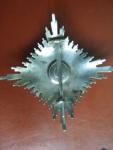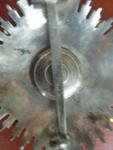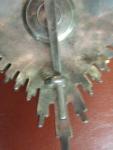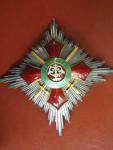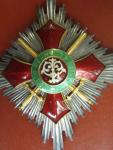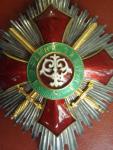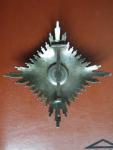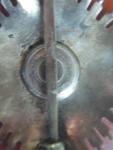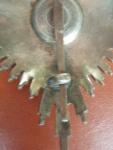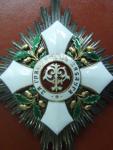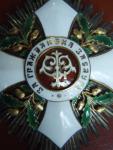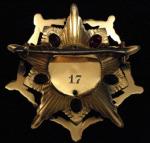-
Posts
1,199 -
Joined
-
Last visited
-
Days Won
1
Content Type
Profiles
Forums
Blogs
Gallery
Events
Store
Everything posted by new world
-

Romanian Order of the Star- quick question
new world replied to P.F.'s topic in Central & Eastern European States
Thank you for the illustration, but Isn't that a contradiction - peacetime award during WWII? -
Collectables can be viewed as investment into art. There are numerous individuals and investment funds who use art and antiques as supplemental investment vehicles. They also can be effective diversification instrument. For example, some Russian banks have dedicated professionals who search for and invest into Russian Imperial awards. I've seen some of them at the military fairs and auctions buying Russian awards for their investment portfolios. It's quite profitable as well, as since beginning of 2000s until 2008-09 prices of Russian awards increased several fold. The prices came down during last credit crisis, but they still at very nice levels. But of course this applies only to some awards, not all awards realized such profits. There's a special class of investments, called Alternative Investments. Many private and hedge funds invest into them. There are some studies of the market, for example: ART AS AN INVESTABLE ASSET CLASS There are several reasons why art has become increasingly popular as an investable asset class. These reasons include: - High net worth individuals see investing in art as a strategy for accumulating wealth. Newly wealthy investors in countries such as China, Brazil, India, and Russia demand art and as a result have driven up auction prices for art. - The demand for art has been generally strong through time. Investors may profit from inefficiencies due to private valuations and illiquidity in the market for art. In addition, there is a lack of transparency in auction markets because while auctions are public, clearing prices for works of art are not. - Art values are typically independent of financial market asset values. It is difficult to construct an art index to measure performance because art markets are characterized by infrequent transactions. Also, the assets themselves are quite unique and prices tend to be smoothed due to infrequent trading. In these ways, art is a bit like commercial real estate. Additionally, there might be great demand in one sector of the market, leading to incorrect assumptions about demand and prices in other sectors. Two index construction methods exist that attempt to deal with the issues of illiquidity and heterogeneity. They are: Hedonic price estimators. This regression method creates a continuous price series by controlling for the unique characteristics of art that changes hands (i.e., actual prices from infrequent transactions). Repeat sales estimators. The repeat sales methodology is a technique used to determine price trends and returns for idiosyncratic assets. This regression method focuses on art that changes hands more than once (i.e., the method uses pairs of observations on the same asset). These methods are also used to construct real estate indices because, like works of art, real estate assets are heterogeneous and illiquid. Studies of art returns are normally based on hammer prices. The hammer price is the final auction price, but does not take the commission to the auction house into consideration. Commissions are quite high and can amount to up to 25% on a round-turn transaction (i.e., commissions are paid when you buy and then when you sell the artwork). Assuming 25% total buy and sell commissions, it can take an investor 10 years of price appreciation to recover the commission charges, based on the 2.2% long-term median real rate of return on art. The financial returns are low but some argue that it is the combined financial benefit with the non-financial benefits of ownership (i.e., the joy of owning, viewing, and controlling the art) that drive some investors to hold art. There are two interesting idiosyncrasies of the art market that might help investors develop an investment strategy based on purchasing art. First, there is the masterpiece effect. This theory argues that expensive art is different from the rest of the market and returns will differ as well. However, ex ante there is no clear indication of whether masterpieces should perform better or worse than the market. In a review of the related academic literature, only one study out of six found a positive masterpiece effect. Second is the question of whether a law of one price in art markets is important to the investor's strategy. There is only weak evidence to reject the law of one price in art markets. In other words, prices do not vary significantly across geographic markets. A Picasso in London is priced similarly to a Picasso in New York. This means investors cannot arbitrage differences across locations and auction houses. Spaenjers (2010)4 considers more than one million art transactions across 13 countries beginning in the 1960s. He finds that holding period returns average approximately 2% annually, the standard deviation of returns is approximately 17% annually, and prices do not vary much across markets. He also finds that currency fluctuations are not a significant driver of art returns. Higher quality paintings (i.e., the quality effect) earned higher returns and had higher volatility of returns in the Spaenjers study. In the study, Spaenjers finds that art prices are significantly explained by wealth effects (proxied by GDP growth), income inequality, and lagged equity market effects. Unfortunately, high net worth individuals are already exposed to these factors, reducing the diversification benefits of art. Spaenjers, C. 2010, "Returns and Fundamentals in International Art Markets." American Art. http://www.hec.unil.ch/documents/seminars/ibf/430.pdf
-

Bulgaria FAKE BULGARIAN ORDERS ON THE MARKET
new world replied to Graf's topic in Central & Eastern European States
That "set" with fake star has been selling at Liverpool Medals for few years. Box is also not original, someone tried to convert a box from completely different award (not Bulgarian) to increase the value of this "set". I alerted the dealer about the star/box and explained what's wrong with the award, but they did nothing and continue to sell it. It's been at least TWO years... so sad that dealer knowingly sells fakes. -

Bulgaria FAKE BULGARIAN ORDERS ON THE MARKET
new world replied to Graf's topic in Central & Eastern European States
-

Bulgaria FAKE BULGARIAN ORDERS ON THE MARKET
new world replied to Graf's topic in Central & Eastern European States
-

Bulgaria FAKE BULGARIAN ORDERS ON THE MARKET
new world replied to Graf's topic in Central & Eastern European States
-

Bulgaria FAKE BULGARIAN ORDERS ON THE MARKET
new world replied to Graf's topic in Central & Eastern European States
FAKE ALERT!!!! Two more suspect stars, both having features similar to fakes showed in this thread. For sale by the same seller in Bulgaria. First is Civil Merit 2nd class -

Bulgaria First Bulgarian bravery crosses 1880
new world replied to Igor Ostapenko's topic in Central & Eastern European States
Are you sure that silver cross is Bulgarian Bravery award? Looking at the blurry photos you can't really say with certainty. Shape of the award is similar to Bravery, but image in the center does not look like Bulgarian lion. -

Bulgaria Can Bulgarian Orders Be Researched?
new world replied to medalman90's topic in Central & Eastern European States
No, they can't be researched -

Yugoslavia Liberation of Belgrade - 20. 10. 1944.
new world replied to SasaYU's topic in Southern European & Balkan States
Russian President Putin attended celebraions and parade. He was awarded Order of Serbian Republic 1st class on large chain. This is supposedly the highest award of Serbia. Here's the link to video, Putin recives award on 40 seconds into the video: http://www.bbc.co.uk/russian/multimedia/2014/10/141016_putin_visit_serbia -

Bulgaria First Bulgarian bravery crosses 1880
new world replied to Igor Ostapenko's topic in Central & Eastern European States
Super rare document! Thanks! -

Yugoslavia Hero of Socialst Labor in ebay
new world replied to taka317's topic in Southern European & Balkan States
Hideous piece, those women look scary, especially the one in the center medallion! -

Serbia Order of Takovo Grand Cross- Research Journey
new world replied to Rogi's topic in Southern European & Balkan States
Simply amazing that Igor managed to do this research on normally unnamed award!!! -

Bulgaria Translation of Bulgarian Award Cert
new world replied to P.F.'s topic in Central & Eastern European States
Do you have a scan of second doc? -

Bulgaria Translation of Bulgarian Award Cert
new world replied to P.F.'s topic in Central & Eastern European States
Pierce - welcome! In your initial post there are TWO documents to Milch. What's the other document? -

Bulgaria Translation of Bulgarian Award Cert
new world replied to P.F.'s topic in Central & Eastern European States
It's for Grand Cross. Awarded to Lieutanant-General E Milch, State Secretary of Aviation Ministry. Very impressive doc! Do whether it's in a museum or in a collection? -

Bulgaria Translation of Bulgarian Award Cert
new world replied to P.F.'s topic in Central & Eastern European States
These look like 2 different documents. Grand and 1st class are not the same. Do you have full pics of his documents? -

Bulgaria Translation of Bulgarian Award Cert
new world replied to P.F.'s topic in Central & Eastern European States
Lieutenant Milch at the time of awarding was a Secretary in German Ministry of Aviation. He later became a Fieldmarshal in Nazi Germany. -

Bulgaria FAKE BULGARIAN ORDERS ON THE MARKET
new world replied to Graf's topic in Central & Eastern European States
This is scary development. Until now there were no decent fakes of mid and low level Bulgarian awards, only high classes and stars. It looks like fakers are moving downstream, so watch out! -

Yugoslavia Hero of Socialst Labor in ebay
new world replied to taka317's topic in Southern European & Balkan States
-

Yugoslavia Hero of Socialst Labor in ebay
new world replied to taka317's topic in Southern European & Balkan States
More questions than answers... -

Yugoslavia Hero of Socialst Labor in ebay
new world replied to taka317's topic in Southern European & Balkan States
I meant not done at the state mint, not in the same facility where awards were made.





